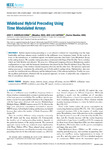Wideband Hybrid Precoding Using Time Modulated Arrays

Use this link to cite
http://hdl.handle.net/2183/26251Collections
- Investigación (FIC) [1724]
Metadata
Show full item recordTitle
Wideband Hybrid Precoding Using Time Modulated ArraysDate
2020-08-05Citation
J. P. González-Coma and L. Castedo, "Wideband Hybrid Precoding Using Time Modulated Arrays," in IEEE Access, vol. 8, pp. 144638-144653, 2020, doi: 10.1109/ACCESS.2020.3014471.
Abstract
[Abstract]
Hybrid digital-analog precoding is a cost effective solution for transmitting over the large bandwidths and huge antenna arrays available in the millimeter wave frequency bands. In this work we focus on the transmission of wideband signals over hybrid precoders that utilize Time-Modulated Arrays in the analog domain. We consider analog precoders constructed with Single-Pole-Double-Throw switches which are both flexible and efficient. We pose two Orthogonal Frequency-Division Multiplexing symbol configurations to cope with the harmonic interference introduced by the Time-Modulated Array. One does not take advantage of the wireless channel frequency diversity and the other does. We optimize digital and analog precoders to maximize the achievable rate in both symbol configurations. Optimization takes into account the switching devices efficiency and the inherent losses of this antenna technique. Finally, we show the excellent performance obtained with the proposed approach, in terms of achievable rate, compared to that of conventional phased arrays.
Keywords
Adaptive arrays
Antenna arrays
Energy efficiency
Massive MIMO
Millimeter wave communication
OFDM modulation
Precoding
RF signals
Wireless communication
Antenna arrays
Energy efficiency
Massive MIMO
Millimeter wave communication
OFDM modulation
Precoding
RF signals
Wireless communication
Editor version
Rights
Atribución 4.0 España
ISSN
2169-3536






